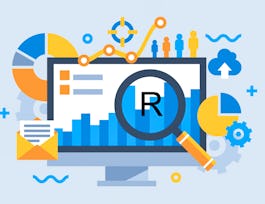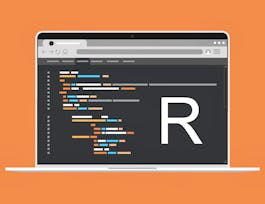The R programming language is purpose-built for data analysis. R is the key that opens the door between the problems that you want to solve with data and the answers you need to meet your objectives. This course starts with a question and then walks you through the process of answering it through data. You will first learn important techniques for preparing (or wrangling) your data for analysis. You will then learn how to gain a better understanding of your data through exploratory data analysis, helping you to summarize your data and identify relevant relationships between variables that can lead to insights. Once your data is ready to analyze, you will learn how to develop your model and evaluate and tune its performance. By following this process, you can be sure that your data analysis performs to the standards that you have set, and you can have confidence in the results.


Data Analysis with R
This course is part of multiple programs.
Taught in English
Some content may not be translated



Instructors: Tiffany Zhu
22,925 already enrolled
Included with 
Course
(269 reviews)
95%
What you'll learn
Prepare data for analysis by handling missing values, formatting and normalizing data, binning, and turning categorical values into numeric values.
Compare and contrast predictive models using simple linear, multiple linear, and polynomial regression methods.
Examine data using descriptive statistics, data grouping, analysis of variance (ANOVA), and correlation statistics.
Evaluate a model for overfitting and underfitting conditions and tune its performance using regularization and grid search.
Details to know

Add to your LinkedIn profile
11 quizzes
Course
(269 reviews)
95%
See how employees at top companies are mastering in-demand skills

Build your subject-matter expertise
- Learn new concepts from industry experts
- Gain a foundational understanding of a subject or tool
- Develop job-relevant skills with hands-on projects
- Earn a shareable career certificate


Earn a career certificate
Add this credential to your LinkedIn profile, resume, or CV
Share it on social media and in your performance review

There are 6 modules in this course
All data analysis starts with a problem that you need to solve and understanding your data and the types of questions you can answer about it are key aspects of this. The R programming language provides you with all the tools you need to conduct powerful data analysis, providing the conduit between your data and the real-world problems you want to solve. In this module, you’ll review a type of problem that you can solve in R and the underlying data that forms the basis for your analysis. You’ll also learn about the R packages for data analysis, which provide a powerful set of tools that you’re likely to use in everyday data analyses. Finally, you’ll see how to import data and gain basic insights from the dataset.
What's included
6 videos1 reading2 quizzes1 app item1 plugin
Data wrangling, or data pre-processing, is an essential first step to achieving accurate and complete analysis of your data. This process transforms your raw data into a format that can be easily categorized or mapped to other data, creating predictable relationships between them, and making it easier to build the models you need to answer questions about your data. This module provides an introduction to data pre-processing in R and then provides you with the tools you need to identify and handle missing values in your dataset, transform data formats to align them with other data you may want to compare them to, normalize your data, create categories of information through data binning, and convert categorical variables into quantitative values that can then be used in numeric-based analyses.
What's included
6 videos1 reading2 quizzes1 app item1 plugin
Exploratory data analysis, or EDA, is an approach to analyzing data that summarizes its main characteristics and helps you gain a better understanding of the dataset, uncover relationships between different variables, and extract important variables for the problem you are trying to solve. The main question you are trying to answer in this module is: "What causes flight delays?" In this module, you’ll learn some useful exploratory data analysis techniques that will help answer this question.
What's included
5 videos1 reading2 quizzes1 app item1 plugin
You have identified the problem that you’re trying to solve and have pre-processed the dataset you’ll use in your analysis, and you have conducted some exploratory data analysis to answer some of your initial questions. Now, it’s time to develop your model and assess the strength of your assumptions. In this module, you will examine model development by trying to predict the arrival delay of a flight using the Airline dataset. You’ll learn regression techniques for determining the correlation between variables in your dataset, and evaluate the result both visually and through the calculation of metrics.
What's included
7 videos1 reading2 quizzes1 app item1 plugin
You have a firm understanding of your data and have pre-processed it to ensure the best possible outcomes. And you have conducted exploratory data analysis and developed your model. Everything looks good so far, but how can you be certain your model works in the real world and performs optimally? In this module, you’ll learn how to use the tidymodels framework to evaluate your model. Tidymodels is a collection of packages for modeling and machine learning using tidyverse principles. Using these packages, you’ll learn how to cross-validate your models, identify potential problems, like overfitting and underfitting, and handle overfitting problems using a technique called regularization. You’ll also learn how to tune your models using grid search.
What's included
4 videos1 reading2 quizzes1 app item1 plugin
What's included
4 readings1 quiz1 peer review2 app items3 plugins
Instructors



Offered by
Recommended if you're interested in Data Analysis
Why people choose Coursera for their career




Learner reviews
Showing 3 of 269
269 reviews
- 5 stars
82.22%
- 4 stars
11.85%
- 3 stars
2.22%
- 2 stars
1.11%
- 1 star
2.59%
New to Data Analysis? Start here.

Open new doors with Coursera Plus
Unlimited access to 7,000+ world-class courses, hands-on projects, and job-ready certificate programs - all included in your subscription
Advance your career with an online degree
Earn a degree from world-class universities - 100% online
Join over 3,400 global companies that choose Coursera for Business
Upskill your employees to excel in the digital economy
Frequently asked questions
Access to lectures and assignments depends on your type of enrollment. If you take a course in audit mode, you will be able to see most course materials for free. To access graded assignments and to earn a Certificate, you will need to purchase the Certificate experience, during or after your audit. If you don't see the audit option:
The course may not offer an audit option. You can try a Free Trial instead, or apply for Financial Aid.
The course may offer 'Full Course, No Certificate' instead. This option lets you see all course materials, submit required assessments, and get a final grade. This also means that you will not be able to purchase a Certificate experience.
When you enroll in the course, you get access to all of the courses in the Certificate, and you earn a certificate when you complete the work. Your electronic Certificate will be added to your Accomplishments page - from there, you can print your Certificate or add it to your LinkedIn profile. If you only want to read and view the course content, you can audit the course for free.
If you subscribed, you get a 7-day free trial during which you can cancel at no penalty. After that, we don’t give refunds, but you can cancel your subscription at any time. See our full refund policy.





